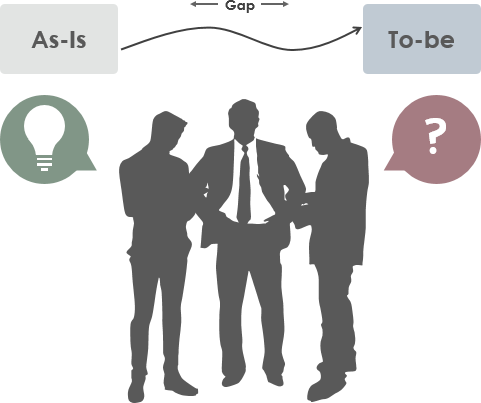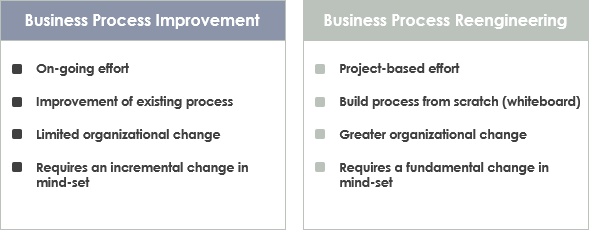Today’s business environment changes rapidly – change is continuous and at an increasing rate. To become and remain successful and competitive, businesses must continuously improve their processes. Failure to do so is likely to result in higher costs, lower revenues, less motivated employees and fewer satisfied customers.

Business Process improvement is a continual process that aims at attaining efficiency through continual improvement by reiterating the processes. BPI is the way you improve current as-is state, where you have problems and issues (look for failure demands, wastes and eliminate them) – so you got to your to-be state.

BPR is a strategy based on aspiration which aims to redesign the process almost from scratch. You go first for customer value propositions. It takes into consideration the input and the desired output and comes up with an efficient process to achieve the aim. Thus, Business Process Reengineering is a radical approach to the current business process. Business process re-engineering necessarily means replacing the existing system.
Business process re-engineering or BPR is a technique of change management to clean-up the fat layers by introducing radical changes in operational strategy which should, in turn, result in competitive advantages. It is typically driven by rapid growth (the need for scalability), mergers and acquisitions (integration of operations), pre/post IPO (transformation to an operating company) or restructuring to improve organizational effectiveness and operational efficiency.
Both BPR and BPI essentially aim to improve the system. Business process reengineering involves completely changing the process for an overall different result, which is the opposite of incremental business process improvement. BPR aims at changing the way a process works while BPI is tweaking an existing process to optimize it. But the difference is in the depth of change.
Here are some key differences between BPO and BPR:

Some organizations shy away from process reengineering because they feel it is too costly and too time-consuming. The questions asked by them are: “Why scrap a process when we can try to fix it instead?” The answer is to investigate and appreciate the problem.
Companies need to determine whether a certain process within the organization requires minor healing (continuous process improvement) or major surgery (process, reengineering). Generally speaking, it depends on the circumstances facing the business. While process improvement efforts should be guided by organizational efforts, it is important to put these approaches in context to determine which is suitable. Here are some guidelines for deciding whether to apply BPI or BPR: